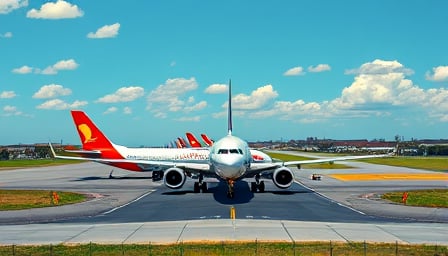United Airlines Holdings Inc. Faces a Moderately Positive Outlook Amid Industry Recovery
United Airlines Holdings Inc. has reported a modest rise in its share price, reflecting a broader rebound across the airline sector in the third quarter. Analysts at Jefferies Financial Group have increased their price target for the carrier, signalling a potential upside exceeding 30 %. This adjustment aligns with the prevailing market sentiment that air travel is regaining momentum, yet the magnitude of the growth remains subject to scrutiny.
Market Dynamics and Analyst Perspectives
Jefferies’ revised target is underpinned by several factors:
- Demand Resurgence – Passenger volumes have recovered to roughly 70 % of pre‑pandemic levels, driven by domestic travel and the gradual return of international tourism.
- Cost Management – United’s recent restructuring initiatives, including workforce optimization and fuel hedging, are projected to reduce operating expenses by 3‑5 % over the next 12 months.
- Revenue Diversification – The carrier’s focus on ancillary revenue—particularly through seat selection fees, premium cabin upgrades, and loyalty program monetization—provides a buffer against fluctuating ticket prices.
Despite these positives, analysts caution that the uptick may not translate into substantial earnings growth. The airline industry’s high fixed-cost base and sensitivity to macroeconomic variables, such as fuel prices and exchange rates, could temper profitability. Moreover, the persistent volatility in passenger demand due to evolving travel restrictions and health concerns remains a risk factor.
Strategic Shifts in Premium Services
United Airlines, along with its principal competitors American Airlines and Delta Air Lines, has quietly phased out the traditional “first‑class upgrade perk.” Instead, the carriers are moving toward paid or dynamic upgrade systems that allow passengers to purchase higher‑class seats at a premium or receive upgrades through a bidding mechanism based on loyalty status and real‑time seat availability.
Potential Implications
- Customer Loyalty – The removal of complimentary upgrades could erode perceived value among high‑frequency flyers, potentially weakening brand loyalty.
- Revenue Optimization – Paid upgrades enable airlines to capture willingness‑to‑pay from passengers willing to pay a premium for improved service, potentially boosting ancillary revenue.
- Operational Flexibility – Dynamic upgrade models allow carriers to better match seat inventory with demand, reducing the risk of over‑ or under‑capacity in premium cabins.
The success of this strategic pivot will hinge on the carriers’ ability to balance the short‑term revenue gains against the longer‑term impacts on customer satisfaction and brand equity. If executed effectively, dynamic upgrades could become a new standard in the industry, offering a scalable revenue stream while maintaining service quality.
Broader Economic Context
The airline industry’s performance is intrinsically linked to macroeconomic conditions:
- Consumer Spending – As disposable income rises, leisure travel demand is likely to increase, supporting revenue growth.
- Fuel Price Fluctuations – Crude oil prices continue to be a primary cost driver; hedging strategies and fuel‑efficiency initiatives remain critical.
- Labor Market Dynamics – The labor shortage in aviation and the rising wage expectations influence operating costs and staffing strategies.
United Airlines’ operational and financial strategies must therefore remain adaptive, leveraging data analytics and market intelligence to navigate these broader forces. A rigorous assessment of competitive positioning—considering route network, fleet composition, and ancillary service offerings—will be essential to sustaining long‑term profitability.
In conclusion, United Airlines Holdings Inc. exhibits a cautiously optimistic outlook, buoyed by a recovering travel market and strategic cost‑control measures. However, the transition away from complimentary first‑class upgrades and the inherent volatility of the airline sector underscore the need for vigilant management and continuous market analysis to secure sustained growth.
